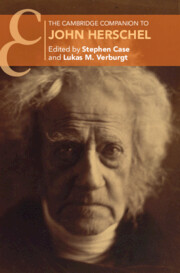Book contents
- The Cambridge Companion to John Herschel
- The Cambridge Companion to John Herschel
- Copyright page
- Contents
- Figures
- Contributors
- Acknowledgments
- Chronology
- Introduction
- 1 John Herschel
- 2 The Mathematical Journey of John Herschel
- 3 John Herschel’s Astronomy
- 4 Stargazer at World’s End
- 5 Herschel’s Philosophy of Science
- 6 Drawing Observations Together
- 7 Photology, Photography, and Actinochemistry
- 8 Herschel’s Planet
- 9 John Herschel and Scientific Standardization
- 10 John Herschel and Politics
- 11 John Herschel’s Methodology in the Scientific Community
- Further Reading
- Index
6 - Drawing Observations Together
John Herschel and the Art of Drawing in Scientific Observations
Published online by Cambridge University Press: 08 May 2024
- The Cambridge Companion to John Herschel
- The Cambridge Companion to John Herschel
- Copyright page
- Contents
- Figures
- Contributors
- Acknowledgments
- Chronology
- Introduction
- 1 John Herschel
- 2 The Mathematical Journey of John Herschel
- 3 John Herschel’s Astronomy
- 4 Stargazer at World’s End
- 5 Herschel’s Philosophy of Science
- 6 Drawing Observations Together
- 7 Photology, Photography, and Actinochemistry
- 8 Herschel’s Planet
- 9 John Herschel and Scientific Standardization
- 10 John Herschel and Politics
- 11 John Herschel’s Methodology in the Scientific Community
- Further Reading
- Index
Summary
As early as 1826, John Herschel wrote, “astronomers are seldom draftsmen, and have hitherto … contented themselves with very general and hasty sketches.”1 This was more than a passing complaint with past depictions of astronomical objects. It was an exhortation to a generation of astronomers to begin taking draftsmanship seriously. With its increasing focus on the physical features of astronomical bodies like the Sun, the planets, comets, and the Moon, as well as the intricate physical complexities of the Milky Way, celestial nebulae, and clusters of stars, the astronomy of the nineteenth century demanded a new and systematic focus on draftsmanship as a means of observation. In this way, astronomy was very much in line with other observational sciences of the period like geology and minerology, botany and zoology, archaeology and ethnography, all of which required, alongside detailed descriptions, more exact pictures of their respective subject matter.2 As the act of drawing became embedded into routine scientific recordkeeping practices, it also became closely tied to what counted as proper scientific observation. Herschel was not just in tune with these important developments, he exemplified them in his own observational performances. This is evinced by his exquisite skills and techniques in drawing in the service of science and, above all, astronomy. Herschel’s observational practices were embodied in a set of visualizing instruments, techniques, and materials. What follows is a survey of some of these practices as they range over a lifetime of carefully observing and drawing many sorts of phenomena.
- Type
- Chapter
- Information
- The Cambridge Companion to John Herschel , pp. 127 - 159Publisher: Cambridge University PressPrint publication year: 2024



